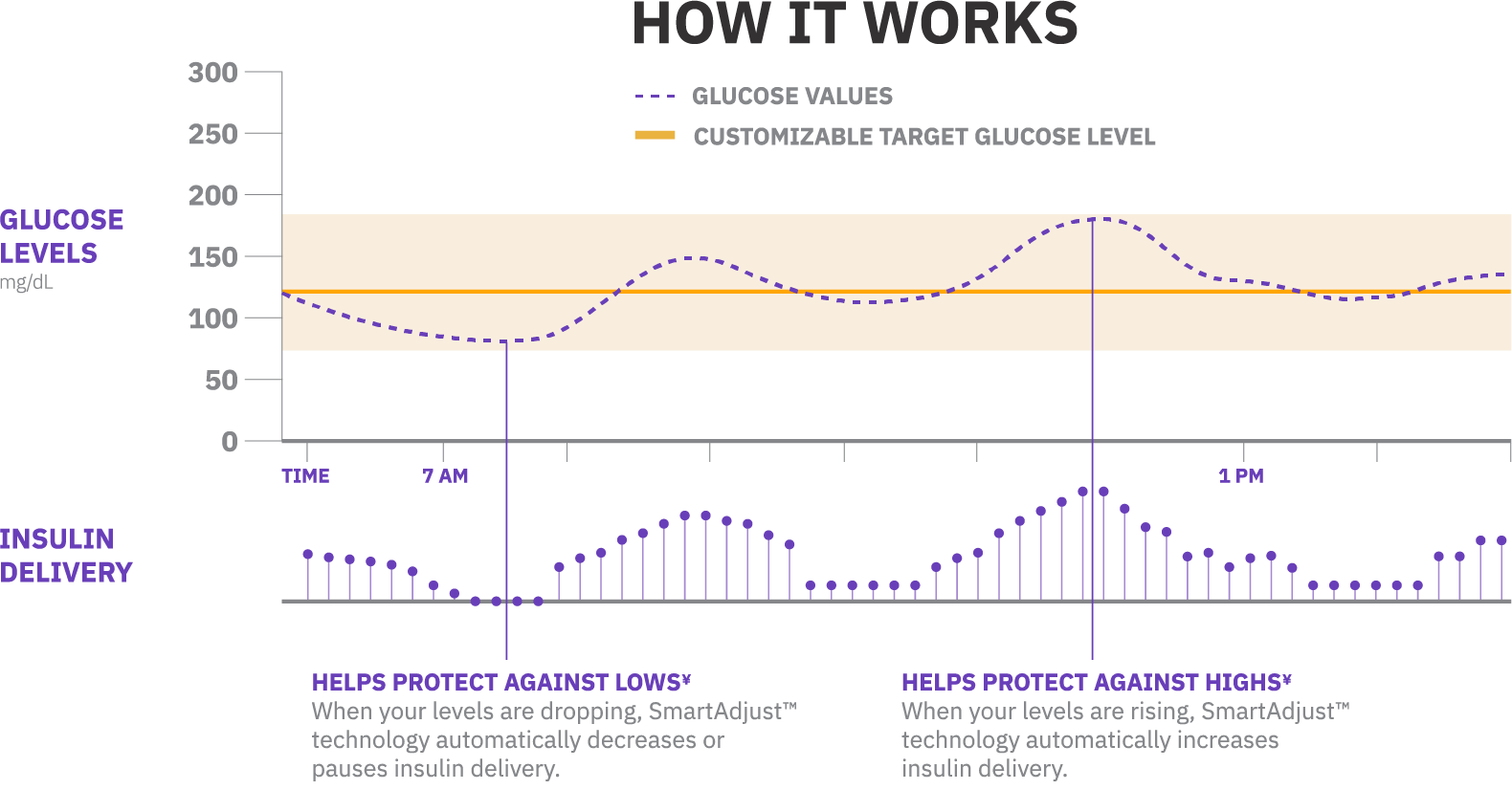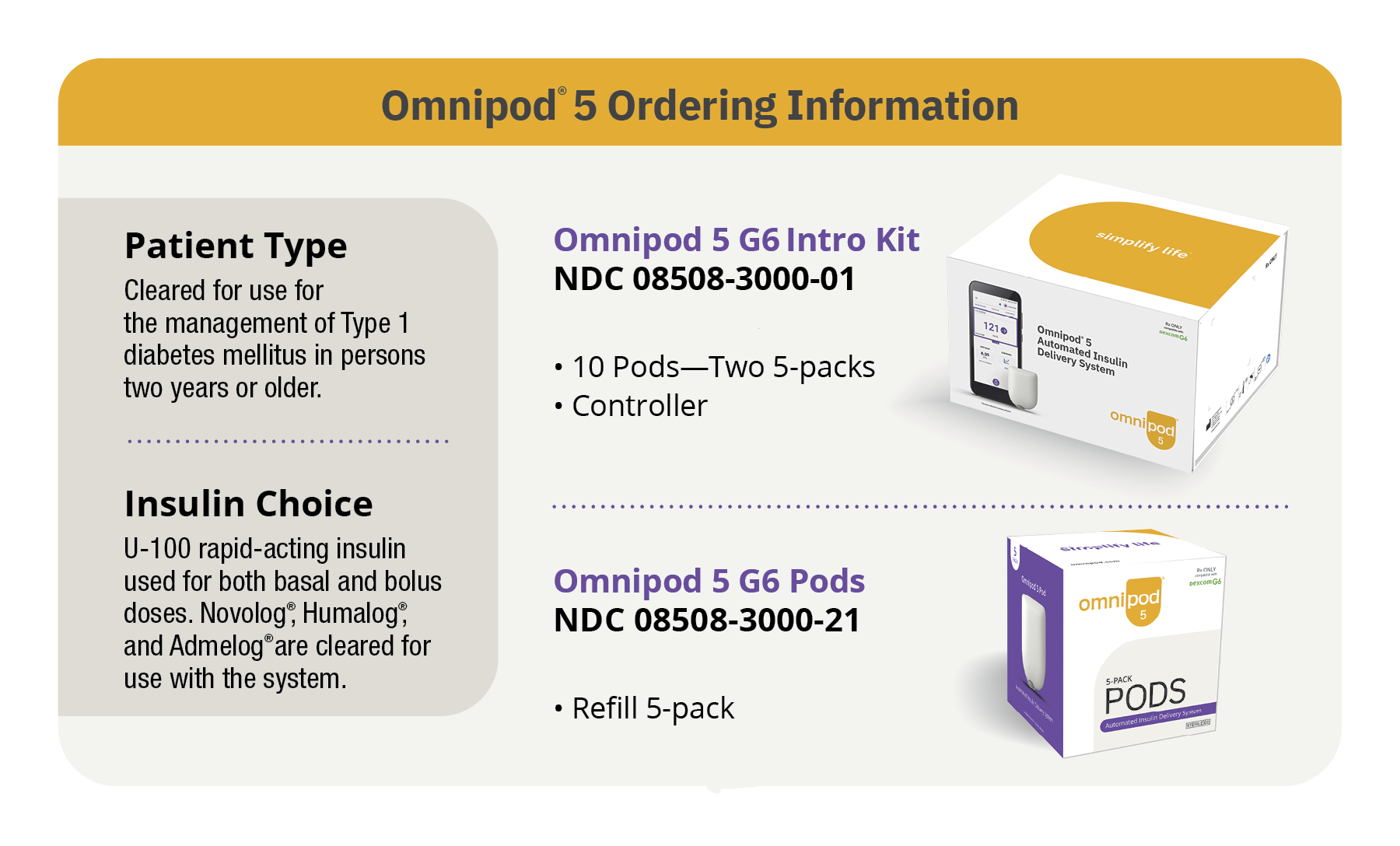Simplify Life with Tubeless, Automated Insulin Delivery
Omnipod® 5: Tubeless, automatic insulin adjustments
Omnipod® 5, the first and only tubeless, automated insulin delivery system to integrate with Dexcom G6®, is now available. Omnipod® 5 helps simplify life with diabetes: no multiple daily injections, tubes, or fingersticks* necessary!
- Cleared for people with type 1 diabetes aged 2 years and older
- Helps keep you in range day and night¥
- Monitor your glucose levels and insulin dosing all with the option for full control right from your compatible smartphone†.
- Just like Omnipod DASH®️, it includes a waterproof‡ tubeless insulin Pod that can be worn almost anywhere you’d inject insulin.
- Each Pod still lets you trade multiple daily injections for up to 3 days (72 hours) of continuous insulin delivery.
Now, the Pod is automated, CGM integrated, and highly anticipated simplifying life in so many ways.
†For a list of compatible smartphone devices visit omnipod.com/compatibility.
‡The Pod has an IP28 rating for up to 25 feet for 60 minutes. The Controller is not waterproof.
3 Simple Parts
To the Omnipod 5 Automated Insulin Delivery System


Omnipod® 5 App*
Take full control of the Pod from the Omnipod® 5 App on a compatible smartphone† or use the free Controller, included at no additional cost, with your prescription for the Omnipod® 5 Intro Kit.
Pod
Tubeless, wearable and waterproof‡, the state-of-the-art Pod, with built in SmartAdjust™ technology, sits right on your body and automatically adjusts insulin delivery for up to 3 days or 72 hours.
Dexcom G6® CGM System
Continuously sends glucose readings to the Pod, so you can get real-time data without the fingersticks*. Dexcom G6® is sold separately**.
Always adjusting, so you don’t have to
With SmartAdjust™ technology, Omnipod® 5 and the Dexcom G6® CGM* are in constant communication, enabling automatic insulin adjustments to help improve time in range.¥






Want to receive news and updates from the Insulet team?
¥. Brown S. et al. Diabetes Care. 2021;44:1630-1640. Prospective pivotal trial in 240 participants with T1D aged 6 - 70 yrs. Study included a 14-day standard therapy (ST) phase followed by a 3-month Omnipod 5 hybrid closed-loop (HCL) phase. Mean time in range (70-180mg/dL) in adults/adolescents and children as measured by CGM: ST = 64.7%, 3-mo Omnipod 5 = 73.9%, P<0.0001; ST = 52.5%, 3-mo Omnipod 5 = 68.0%, P<0.0001, respectively. Mean time > 180 mg/dL (12AM-6AM) as in adults/adolescents and children, ST vs. 3-mo Omnipod 5: 32.1% vs. 20.7%; 42.2% vs. 20.7%, P<0.0001, respectively. Mean time >180 mg/dL (6AM -12AM) in adults/adolescents and children, ST vs. 3-mo Omnipod 5: 32.6% vs. 26.1%; 46.4% vs. 33.4%, P<0.0001, respectively. Median time in <70 mg/dL (12AM-6AM) in adults/adolescents and children, ST vs. 3-mo Omnipod 5: 2.07% vs. 0.82%,P<0.0001; 0.78% vs. 0.78%, P=0.0456, respectively. Median time <70 mg/dL (6AM-12AM) in adults/adolescents and children, ST vs. 3-mo Omnipod 5: 1.91% vs. 1.08%, P<0.0001; 1.17% vs. 1.62%, P=0.2545, respectively. Results measured by CGM.
1.Brown S. et al. Diabetes Care. 2021;44:1630-1640. Prospective pivotal trial in 240 participants with T1D aged 6-70 yrs[adults/adolescents(n= 128; aged 14-70 yrs) children (n=112; aged 6-13.9 yrs)]. Study included a 14-day standard therapy (ST) phase followed by a 3-month Omnipod 5 hybrid closed-loop phase. Mean HbA1c in adults/adolescents and children, ST vs. 3-mo Omnipod 5:7.16% vs 6.78%, P<0.0001; 7.67% vs 6.99%, P<0.0001, respectively. Mean time in range 70-180mg/dL as measured by CGM in adults/adolescents and children, ST = 64.7%, 3-mo Omnipod 5 = 73.9%, P<0.0001; ST = 52.5%, 3-mo Omnipod 5 =68.0%, P<0.0001, respectively. Median time <70 mg/dL in adults/adolescents and children, ST vs. 3-mo Omnipod 5: 2.0% vs. 1.1%,P<0.0001 (comparison is a relative change); 1.4% vs. 1.5%, P=0.8153, respectively.
2. Sherr JL, et al. Prospective trial in 80 participants with T1D aged 2-5.9 yrs. Study included a 14-day standard therapy (ST) phase followed by a 3-month Omnipod 5 hybrid closed-loop (HCL) phase. Mean overnight time >180 mg/dL (12AM-6AM) as measured by CGM: ST = 38.4%, 3-mo Omnipod 5 = 16.9%, P<0001. Mean daytime >180 mg/dL (6AM-12AM) as measured by CGM: ST = 39.7%, 3-mo Omnipod 5 = 33.7%, P<0001. Median overnight time in <70 mg/dL (12AM-6AM) as measured by CGM: ST = 3.41%, 3-mo Omnipod 5 = 2.13%, P=0.0185. Median daytime <70 mg/dL (6AM-12AM) as measured by CGM: ST = 3.44%, 3-mo Omnipod 5 = 2.57%, P=0.0799.
Risk Statement
The Omnipod 5 Automated Insulin Delivery System is indicated for use by individuals with type 1 diabetes mellitus in persons 6 years of age and older. The Omnipod 5 System is intended for single patient, home use and requires a prescription. The Omnipod 5 System is compatible with the following U-100 insulins: NovoLog®, Humalog®, and Admelog®.
The Omnipod 5 ACE Pump (Pod) is intended for the subcutaneous delivery of insulin, at set and variable rates, for the management of diabetes mellitus in persons requiring insulin. The Omnipod 5 ACE Pump is able to reliably and securely communicate with compatible, digitally connected devices, including automated insulin dosing software, to receive, execute, and confirm commands from these devices. SmartAdjust™ technology is intended for use with compatible integrated continuous glucose monitors (iCGM) and alternate controller enabled (ACE) pumps to automatically increase, decrease, and pause delivery of insulin based on current and predicted glucose values. The Omnipod 5 SmartBolus Calculator is intended to calculate a suggested bolus dose based on user-entered carbohydrates, most recent sensor glucose value (or blood glucose reading if using fingerstick), rate of change of the sensor glucose (if applicable), insulin on board (IOB), and programmable correction factor, insulin to carbohydrate ratio, and target glucose value.
WARNING: SmartAdjust technology should NOT be used by anyone under the age of 6 years old. SmartAdjust technology should also NOT be used in people who require less than 6 units of insulin per day as the safety of the technology has not been evaluated in this population.
The Omnipod 5 System is NOT recommended for people who are unable to monitor glucose as recommended by their healthcare provider, are unable to maintain contact with their healthcare provider, are unable to use the Omnipod 5 System according to instructions, are taking hydroxyurea as it could lead to falsely elevated CGM values and result in over-delivery of insulin that can lead to severe hypoglycemia, and do NOT have adequate hearing and/or vision to allow recognition of all functions of the Omnipod 5 System, including alerts, alarms, and reminders. Device components including the Pod, CGM transmitter, and CGM sensor must be removed before Magnetic Resonance Imaging (MRI), Computed Tomography (CT) scan, or diathermy treatment. In addition, the Controller and smartphone should be placed outside of the procedure room. Exposure to MRI, CT, or diathermy treatment can damage the components. Visit www.omnipod.com/safety for additional important safety information.
WARNING: DO NOT start to use the Omnipod 5 System or change settings without adequate training and guidance from a healthcare provider. Initiating and adjusting settings incorrectly can result in over-delivery or under-delivery of insulin, which could lead to hypoglycemia or hyperglycemia.